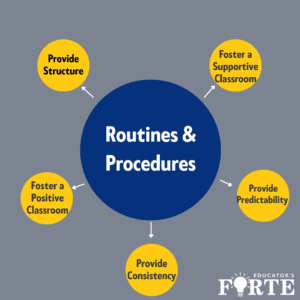Why Training Students on Routines and Procedures is Vital
Training students on instructional routines and classroom procedures is of paramount importance in creating an effective learning environment. Routines and procedures provide structure, predictability, and consistency, which are essential for fostering a positive and supportive classroom atmosphere. When students are familiar with the daily routines, they experience a sense of security and know what to expect, leading to reduced anxiety and disruptions. This predictability also helps in managing student behavior and creates a well-organized and smoothly functioning classroom.
Although training students takes some time initially, it saves so much more time later. Having well-trained students optimizes classroom time, ensuring that instructional minutes are utilized to their fullest potential. By streamlining activities, transitions, and materials management, teachers can dedicate more time to actual learning and students become more efficient in completing tasks.
One significant advantage of training students on classroom procedures is the reduction of behavioral issues. Clearly defined procedures and expectations minimize off-task behaviors and disruptions. When students are aware of expectations, they are more likely to exhibit appropriate behavior and make appropriate choices. This, in turn, allows teachers to dedicate their time and energy to delivering engaging instruction and facilitating student learning instead of dealing with discipline issues.
Beyond behavioral management, training students on routines and procedures cultivates a sense of responsibility and independence. As students learn to navigate classroom expectations, they become more self-sufficient learners. They take ownership of their learning process, confidently organizing materials, seeking assistance when needed, and collaborating effectively with peers. This level of independence empowers students with a growth mindset and a proactive attitude toward learning.
Basic Training: How and When to Train Students
Training students on routines and procedures is an ongoing and intentional process that begins at the start of the school year and continues throughout the school year. Below we offer some strategies for training students on the expected routines and procedures. Consider each of them, and as you create your classroom management plan (including instructional routines you plan to use), create a detailed plan on how you’ll teach and enforce these expected behaviors.
- Explicit Instruction and Practice: At the beginning of the year, allocate time for explicit instruction on each routine and procedure. Clearly explain and demonstrate the expectations to students. For example, actually demonstrate how to enter the classroom quietly for students, or how to line up for a transition, or how to access materials for a specific activity. After the demonstration, provide opportunities for students to practice these routines as the need arises. Repeated practice allows students to become comfortable and proficient in executing the procedures. (Note that if the “need” for a routine doesn’t arise very often, then you probably don’t need that routine.)
- Modeling and Role-Playing: Model the desired behaviors and procedures for your students. Show them what it looks like when routines are carried out correctly and discuss the benefits of following these procedures. Additionally, engage students in role-playing activities where they act out both the correct and incorrect ways to follow the procedures. Role-playing helps them identify best practices and understand the potential consequences of not adhering to the routines.
- Classroom Walkthroughs: Teachers usually associate classroom walkthroughs as something school leadership does. Now it’s your turn! Conduct classroom walkthroughs where you observe students. Do this regularly to reinforce the importance of following routines and procedures. During these walkthroughs, observe students’ adherence to established procedures and provide positive reinforcement for those who demonstrate responsible behavior. If needed, offer constructive feedback and additional guidance for improvement.
- Consistency: Consistency is key in reinforcing routines and procedures. Where you’ve taken the time to define instructional routines and classroom procedures, but sure that you consistently use those routines. If you do not, students may understand what you expected but also realize that you aren’t serious about them using particular routines. So be sure to create opportunities for using the various routines and procedures you’ve established—especially early on while you are initially training students.
Mission Accomplished: A Well-Trained Classroom in Action
Just what does this well-trained classroom look like? It looks like a classroom with effective classroom management! Below we offer a list of exemplar observable characteristics of this classroom in action. You may determine additional characteristics based on the routines and procedures you choose to implement.
- Smooth Transitions: Students move seamlessly from one activity to another, following established routines for transitions. They know what to do, where to go, and how to prepare for the next activity, without excessive teacher direction.
- Independent Problem-Solving: Well-trained students demonstrate independence in managing their learning and navigating classroom procedures. They know how to access learning resources, handle technical difficulties, and seek assistance when needed, without relying heavily on teacher intervention.
- Respectful and Engaged: Students in a well-trained classroom show respect for classroom norms and for each other. They actively participate in discussions, contribute to group activities, and engage thoughtfully with the curriculum.
- Minimal Disruptions: Behavioral disruptions are minimized in a classroom with well-trained students. They understand and internalize the procedures and expectations, reducing the need for frequent redirection from the teacher.
- Focus on Learning: With efficient routines and procedures in place, the majority of classroom time is dedicated to learning and meaningful engagement with the curriculum. Students are focused, on-task, and eager to participate in educational activities.
- Positive and Supportive Atmosphere: A classroom with well-trained students fosters a sense of community and mutual respect. Students support one another in their learning, collaborate effectively, and contribute to a positive and supportive classroom atmosphere.
- Confidence and Independence: Students in a well-trained classroom demonstrate confidence and independence in their academic pursuits. They take ownership of their learning, seek out resources, and approach challenges with a growth mindset.
Training students on instructional routines and classroom procedures is a foundational aspect of effective classroom management. When students are equipped with clear expectations and effective routines, they can fully engage in their learning, feel supported, and experience success academically and socially. And you will find yourself closer to the type of classroom management that will make you the envy of the whole school!

Continue to follow us or subscribe to our newsletter to make sure you don’t miss the next article in this series where we will revisit the idea of teacher with-it-ness, how it relates to classroom management, and how you can get with-it if you aren’t already!

